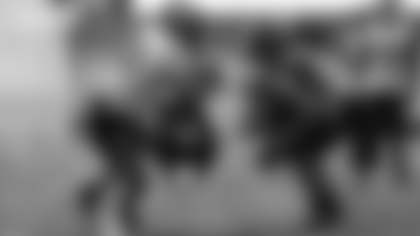LATROBE, Pa. – Let's get to it:
JACK SLUTSKY FROM JERUSALEM, ISRAEL: I understand from Steelers.com that there is one practice in the afternoon each day. What do the players do all day leading up to it?
ANSWER: The schedule varies somewhat, but here is a general idea: There are meetings in the morning, broken down either by position or unit, and then following that there is a walk-through on the field where the coaches go over what was taught in the meetings and the players re-enact it to reinforce what was taught. Then it's lunch time, and following lunch and before the afternoon practice there might be another meeting to go over what is to be worked on during that day's on-field session. After dinner, there are more meetings – special teams meetings and additional position and/or unit meetings. There also is work in the weight room, and conditioning work for those who either need it or want it. Curfew is at 11 p.m.
JASON PRASTER FROM SAN ANTONIO, TX: In my opinion, James Farrior ranks No. 1 on the Steelers' list of unrestricted free agent signings. Rounding out my top five in this category are: Kevin Greene at No. 2; Ryan Clark at No. 3; Kimo von Oelhoffen at No. 4; and Jeff Hartings at No. 5. Which ones would make your top-5 list?
ANSWER: My list, from the top, would be: James Farrior, Jeff Hartings, Kevin Greene, Kimo von Oelhoffen, and Ray Seals. A brief synopsis of each of my five picks:
Farrior entered the league as the New York Jets' No. 1 pick (eighth overall) in 1997, and it was Bill Parcells who made the selection and then installed him as an outside linebacker. But during his five seasons with the Jets, Farrior played for three different head coaches, and by the time 2001 ended he was something of an afterthought in New York. Meanwhile, the Steelers were in negotiations with Earl Holmes, their first pick in the fourth round of the 1996 draft who had grown into a run-stuffing starting inside linebacker. As the 2002 offseason progressed, Steelers President Dan Rooney went as far with Holmes as he was going to go on a new contract, and when the answer from the agent still was "no," Rooney instructed Kevin Colbert and Bill Cowher to move on to another player. That player turned out to be James Farrior. During his 10 seasons with the Steelers, Farrior posted 30 sacks, eight interceptions, and 10 fumble recoveries. He was voted first-team All-Pro in 2004, and played in two Pro Bowls. In 2010, Coach Mike Tomlin said, "Our unquestioned leader is James Farrior. If you polled anybody, player or coach, equipment man or receptionist, they realize he sets the tone for this outfit."
Jeff Hartings entered the NFL as a first-round draft pick of a Detroit Lions team that employed Kevin Colbert in its player personnel department at the time, and when he became an unrestricted free agent, Hartings was an unrestricted free agent guard. He had not played center either for the Lions or during his college career at Penn State. But the Steelers believed Hartings was capable of making the difficult transformation, and so they signed him to replace Dermontti Dawson. Hartings would play six seasons for the Steelers, and during that time he would be voted first-team All-Pro at center, which means for that season he was the best center in the NFL.
The second UFA ever signed by the Steelers, Kevin Greene never would have been pursued if the San Diego Chargers hadn't signed Jerrol Williams to an offer sheet the Steelers declined to match. The reason they declined to match was because it was only a one-year contract and came with a guaranteed salary, and Dan Rooney didn't allow guaranteed contracts. As a starting outside linebacker for the Steelers in 1991 and 1992, Williams had 13.5 sacks over the two seasons. Greene posted 12.5 sacks in 1993 alone, and he finished his three seasons in Pittsburgh with 35.5 sacks. Greene is third on this list because he only played three of his Hall of Fame seasons with the Steelers.
The Steelers were in the market for a nose tackle in 2000 following the departure of Joel Steed, but why would they sign somebody the Cincinnati Bengals didn't want? Such was the prevailing sentiment when the Steelers signed Kimo von Oelhoffen away from a Bengals franchise that had posted records of 3-13, 7-9, 8-8, 7-9, 3-13, and 4-12 during his time in Cincinnati. But history showed the Steelers were right for wanting von Oelhoffen, because after one season as the nose tackle here, he was moved to defensive end where he played with distinction from 2001 through Super Bowl XL after the 2005 season.
Talk about under the radar, Ray Seals was under the radar. First of all, he didn't play college football, and then he graduated from playing for the Syracuse Express of the Empire Football League to a spot on the defensive line for the Tampa Bay Buccaneers, a team that never bettered 6-10 in any of his four seasons there. But it didn't take Seals long to establish himself as a 3-4 rarity – a defensive end who was a dangerous pass rusher. Using a combination of nimble feet and quick hands, Seals posted 15.5 sacks in 1994-95 before tearing a rotator cuff in the 1996 preseason and landing on injured reserve. He would finish his career with the Carolina Panthers.
ROY PERRIN FROM FUQUAY VARINA, NC: Do you see the offensive line staying stable for the 3-to-5 years Ben Roethlisberger said he wants to continue playing football?
ANSWER: As far as the starters, Ramon Foster is signed through the 2018 season and can become an unrestricted free agent in March 2019; both Maurkice Pouncey and Marcus Gilbert are signed through the 2019 season and can become unrestricted free agents in March 2020; Al Villanueva is signed through the 2020 season and can become an unrestricted free agent in March 2021; and David DeCastro is signed through the 2021 season and can become an unrestricted free agent in March 2022. Based on the length of those contracts, it can be said there is a fair amount of stability associated with the starters. But turnover in the NFL also is part of life.
BRAD SMITH FROM ASHLAND, MA: The Steel Curtain was a base 4-3 defense. When and why did the Steelers switch to a base 3-4 defense?
ANSWER: The Steelers switched from a 4-3 defensive alignment to a 3-4 for the 1982 season. Besides the fact that the 3-4 was viewed at the time as an emerging trend that was better suited to stopping the run while providing a defense with more versatility, the Steelers found their roster at the end of the 1981 season to have more linebackers than capable defensive linemen. By the time the 1982 regular season opened, Joe Greene was gone, Ernie Holmes was gone, L.C. Greenwood was gone, Steve Furness was gone. The starting defensive linemen were Tom Beasley, Gary Dunn, and John Goodman, with Edmund Nelson and Keith Willis as the top backups. Chuck Noll made the decision based on the makeup of his own roster and the way the league was trending.
JEREMY SZITAS FROM LOS ANGELES, CA: Is there any reason for me not to keep scrolling through my feed when someone mentions Dez Bryant and the Steelers in the same sentence? If not I'll just keep completely ignoring what I presume to be nonsense.
ANSWER: Excellent presumption on your part.














